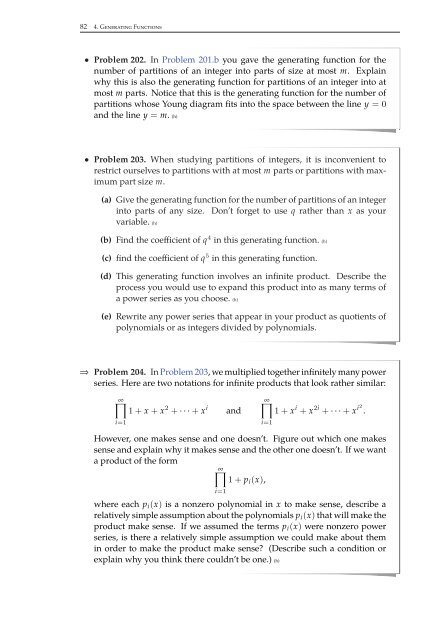Combinatorics Through Guided Discovery, 2004a
Combinatorics Through Guided Discovery, 2004a
Combinatorics Through Guided Discovery, 2004a
Create successful ePaper yourself
Turn your PDF publications into a flip-book with our unique Google optimized e-Paper software.
82 4. Generating Functions<br />
• Problem 202. In Problem 201.b you gave the generating function for the<br />
number of partitions of an integer into parts of size at most m. Explain<br />
why this is also the generating function for partitions of an integer into at<br />
most m parts. Notice that this is the generating function for the number of<br />
partitions whose Young diagram fits into the space between the line y =0<br />
and the line y = m. (h)<br />
• Problem 203. When studying partitions of integers, it is inconvenient to<br />
restrict ourselves to partitions with at most m parts or partitions with maximum<br />
part size m.<br />
(a) Give the generating function for the number of partitions of an integer<br />
into parts of any size. Don’t forget to use q rather than x as your<br />
variable. (h)<br />
(b) Find the coefficient of q 4 in this generating function. (h)<br />
(c) find the coefficient of q 5 in this generating function.<br />
(d) This generating function involves an infinite product. Describe the<br />
process you would use to expand this product into as many terms of<br />
a power series as you choose. (h)<br />
(e) Rewrite any power series that appear in your product as quotients of<br />
polynomials or as integers divided by polynomials.<br />
⇒<br />
Problem 204. In Problem 203, we multiplied together infinitely many power<br />
series. Here are two notations for infinite products that look rather similar:<br />
∞∏<br />
1+x + x 2 + ···+ x i and<br />
i=1<br />
∞∏<br />
1+x i + x 2i + ···+ x i2 .<br />
i=1<br />
However, one makes sense and one doesn’t. Figure out which one makes<br />
sense and explain why it makes sense and the other one doesn’t. If we want<br />
a product of the form<br />
∞∏<br />
1+p i (x),<br />
i=1<br />
where each p i (x) is a nonzero polynomial in x to make sense, describe a<br />
relatively simple assumption about the polynomials p i (x) that will make the<br />
product make sense. If we assumed the terms p i (x) were nonzero power<br />
series, is there a relatively simple assumption we could make about them<br />
in order to make the product make sense? (Describe such a condition or<br />
explain why you think there couldn’t be one.) (h)


















